


Girolamo Macchietti (c. 1535/1541-1592) was an Italian painter active in Florence, working in a Mannerist style.



Girolamo Macchietti (c. 1535/1541-1592) was an Italian painter active in Florence, working in a Mannerist style.
He was a pupil of Michele di Ridolfo. During the years 1556-1562, worked as an assistant to Giorgio Vasari in the decoration of the Palazzo Vecchio, where he worked with Mirabello Cavalori. He participated in the Vasari-directed decoration of the Studiolo of Francesco I with two canvases, one relating a Jason and Medea (1570) and the other a Baths of Pozzuoli (1572). He also painted an altarpiece on the Martyrdom of Saint Lawrence for Santa Maria Novella. In 1577, he completed a Gloria di San Lorenzo for Empoli Cathedral. He traveled to Rome and spent two years in Spain (1587–1589). No works are recorded from these travels.
![]() Media related to Girolamo Macchietti at Wikimedia Commons
Media related to Girolamo Macchietti at Wikimedia Commons

Alessandro di Cristofano di Lorenzo del Bronzino Allori was an Italian painter of the late Mannerist Florentine school.

Michelangelo di Lodovico Buonarroti Simoni, known mononymously as Michelangelo, was an Italian sculptor, painter, architect, and poet of the High Renaissance. Born in the Republic of Florence, his work was inspired by models from classical antiquity and had a lasting influence on Western art. Michelangelo's creative abilities and mastery in a range of artistic arenas define him as an archetypal Renaissance man, along with his rival and elder contemporary, Leonardo da Vinci. Given the sheer volume of surviving correspondence, sketches, and reminiscences, Michelangelo is one of the best-documented artists of the 16th century. He was lauded by contemporary biographers as the most accomplished artist of his era.
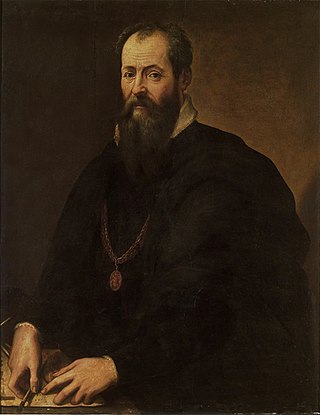
Giorgio Vasari was an Italian Renaissance painter and architect, who is best known for his work Lives of the Most Excellent Painters, Sculptors, and Architects, considered the ideological foundation of all art-historical writing, and still much cited in modern biographies of the many Italian Renaissance artists he covers, including Leonardo da Vinci and Michelangelo, although he is now regarded as including many factual errors, especially when covering artists from before he was born.

The Palazzo Vecchio is the town hall of Florence, Italy. It overlooks the Piazza della Signoria, which holds a copy of Michelangelo's David statue, and the gallery of statues in the adjacent Loggia dei Lanzi.
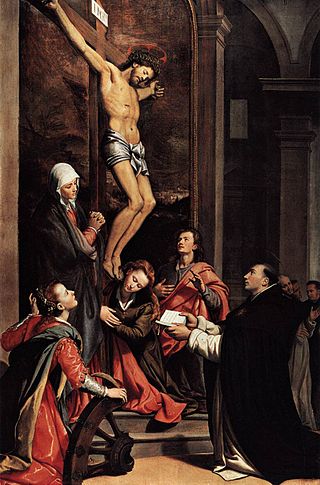
Santi di Tito was one of the most influential and leading Italian painters of the proto-Baroque style – what is sometimes referred to as "Counter-Maniera" or Counter-Mannerism.

Stradanus, Johannes Stradanus, Jan van der Straet or Giovanni Stradano was a Flemish artist active mainly in 16th-century Florence, Italy. He was a wide-ranging talent who worked as an easel and fresco painter, designer of tapestries, draughtsman, designer of prints and pottery decorator. His subject range was varied and included history subjects, mythological scenes, allegories, landscapes, genre scenes, portraits, architectural scenes and animals. After training in his native Flanders, he left his home country and ultimately settled down in Florence, Italy. He became a prominent court artist to the Medici during the second half of the 16th century and worked on the many decorative projects of the court. Stradanus also produced large altarpieces for the most important churches in Florence.
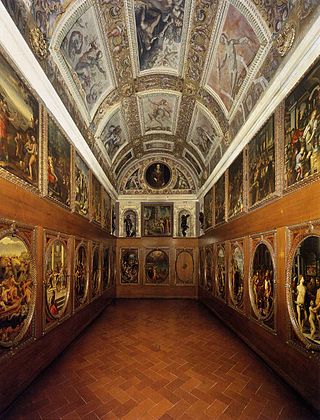
The Studiolo is a small painting-encrusted barrel-vaulted room in the Palazzo Vecchio, Florence, Italy. It was commissioned by Francesco I de' Medici, Grand Duke of Tuscany. It was completed for the duke from 1570 to 1572, by teams of artists under the supervision of Giorgio Vasari and the scholars Giovanni Batista Adriani and Vincenzo Borghini.

Jacopo da Empoli was an Italian Florentine Reformist painter.

Giovanni Battista Naldini (1535–1591) was an Italian painter in a late-Mannerist style, active in Florence and Rome.

Giuliano da Maiano (1432–1490) was an Italian architect, intarsia-worker, and sculptor, the elder brother of Benedetto da Maiano, with whom he often collaborated.

Maso da San Friano (1536–1571) was an Italian painter active in Florence. His real name was Tomaso D'Antonio Manzuoli. He was born in San Friano and died in Florence.

Jacopo Zucchi was a Florentine painter of the Mannerist style, active in Florence and Rome.

Michele Tosini, also called Michele di Ridolfo, (1503–1577) was an Italian painter of the Renaissance and Mannerist period, who worked in Florence.

Giuliano di Piero di Simone Bugiardini was an Italian Renaissance painter. He was born and was mainly active in Florence. He was a painter primarily of religious subjects but he also executed a number of portraits and a few works with mythological subjects.

Santi Buglioni, by the name of Santi di Michele was an important Renaissance Italian sculptor, the nephew and collaborator of Benedetto Buglioni.
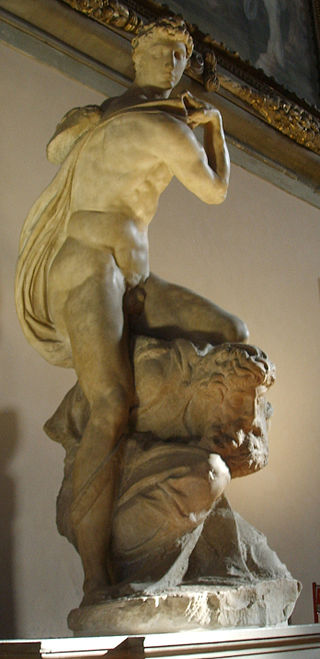
The Genius of Victory is a 1532–1534 marble sculpture by Michelangelo, produced as part of a design for the tomb of Pope Julius II. It is 2.61 m high and is now in the Salone dei Cinquecento of the Palazzo Vecchio in Florence.
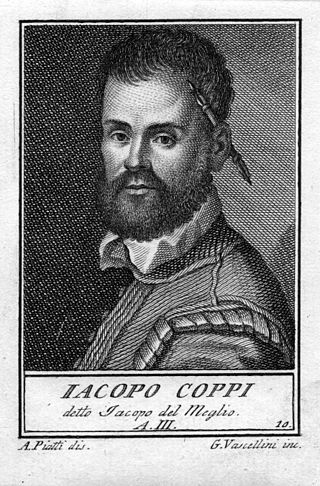
Jacopo Coppi, also called Giacomo Coppi or "'Jacopo del Meglio'" was an Italian painter, mainly active in Florence and Rome in a Mannerist style. Other sources call him Giacinto Coppi.
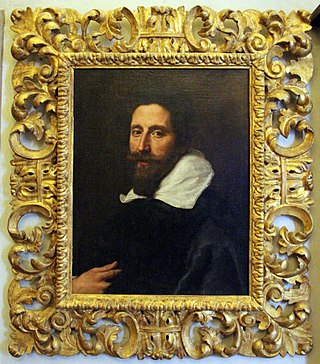
Michelangelo Buonarroti il Giovane was a Florentine poet, librettist and man of letters, known as "the Younger" to distinguish him from his granduncle.

Vincenzo Borghini was an Italian monk, artist, philologist, and art collector of Florence, Italy.